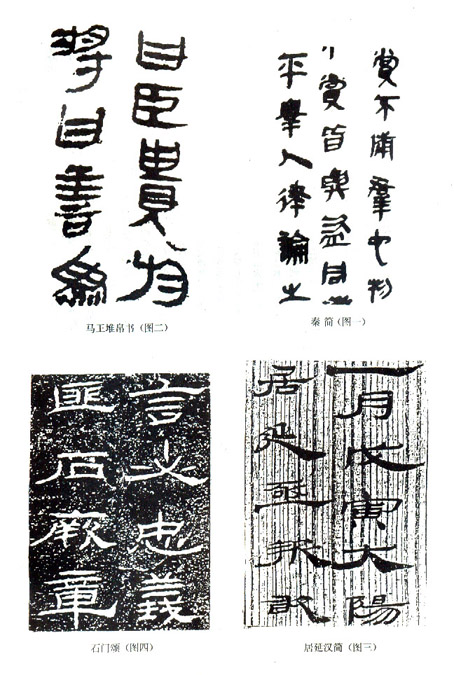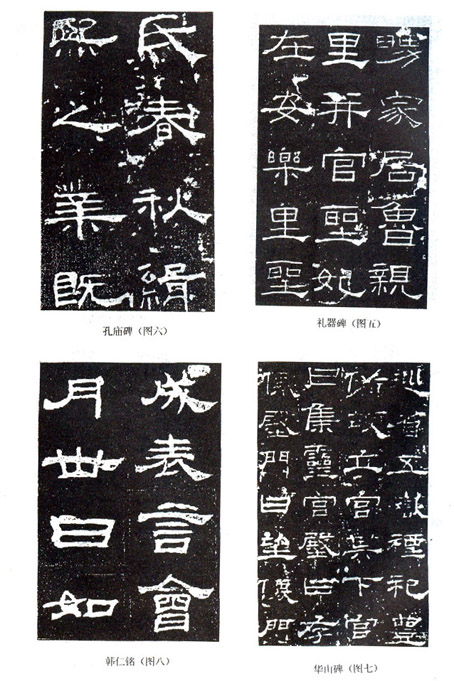Official script is also known as Zuoshu, Fenshu, and Bafen. Because it was popular in the Han Dynasty, it is also called Han Li. It evolved from the round and graceful strokes of seal script into square and folded strokes. The shape of the characters changed from slender to flat and square, with the upper and lower edges tapered. Tight, stretch left and right, the pen movement changes from slow to short speed, thus showing a lively and diverse style, which brings great convenience to the writer. The official script is divided into Qin Li and Han Li.
Qin Li refers to the official script from the Warring States Period, Qin Dynasty to the early Western Han Dynasty, also called ancient Li script. There are many theories about the origin of ancient Li. Judging from the information discovered so far, the Qin Li script originated during the Warring States Period. Judging from the early traces of the official script that appeared on the "wooden tablet" unearthed in Qingchuan County, Sichuan in the second year of King Qin Wu of the Warring States Period (309 BC), the cumbersomeness of the large seal script was detracted from it. The shape of strokes and characters changed from the rectangular shape of seal script to square or flat square. Although its structure still has the flavor of seal script, the prototype of official script has appeared. By the end of the Warring States Period, this prototype of official script had been widely used. Looking at the "Qin Slips" from the 51st year of King Zhaoxiang of Qin (256 BC) unearthed from Yunmengsuihudi, Hubei Province, we can see that this kind of font that looks like both seal script and official script gradually reflects the simplicity and clarity of the glyphs. , the vivid standard of lines. In the large number of wooden tablets, bamboo slips and silk books unearthed from the Warring States Period to the Qin Dynasty, we can see the long process of the evolution of seal script into official script. After Qin Shihuang unified China in 221 BC, he implemented a series of new measures to facilitate his rule, one of which was the "Shu Tongwen". The Prime Minister Li Si of the Qin Dynasty, Zhongshu Ling Zhao Gao and others organized it on the basis of the Warring States characters and unified them into the Xiaozhuan script, which is the official character used throughout the country. Compared with the previous dynasties, Xiaozhuan has made a big step forward in terms of lines, structure, and glyphs. However, the writing method is still round and round, has not completely got rid of the pictographic meaning, and the writing speed is slow. Due to the large number of official prisons at that time and the frequent exchanges of military and government documents and official documents, it was often necessary to copy a large amount of documents. Simplification and reduction of complexity became an urgent demand for writing reform in the society at that time. As a convenient writing style, official script was popular among the lower classes of society. widely popular in. Wei Heng's "Four Types of Calligraphy" said: "Since Qin used seal script, there were many things to do, so it was difficult to write seal script, so it asked someone to help with the calligraphy, called official script.... Those who wrote official script were the best at seal script." This is clear evidence. For the time being, we will not examine who the inventor of official script is, because the creation of a font cannot be created by an individual's power, nor can it be completed in one period. It is gradually formed with the progress of society and actual needs. of.
From the perspective of the thousands of years of development history of Chinese characters, if we classify hieroglyphs to Qin Xiaozhuan as ancient characters, then we classify official script and regular script used today as modern characters. Therefore, official script inherits the rules of seal script and opens the foundation of regular script. It plays a very important role in the history of the development of Chinese characters and calligraphy. Its emergence is an extremely important turning point in terms of practicality and artistry. It is a major change in the evolution of Chinese characters in my country. Since the system of the early Western Han Dynasty inherited the Qin system, including writing, there was no major difference between the official script of the early Western Han Dynasty and that of the Qin Dynasty. It not only has the calligraphy characteristics of the Qin Dynasty, but also laid the foundation for the formation of official script in the Eastern Han Dynasty, playing a role in connecting the past and the future. From the analysis of "Changsha Mawangdui Silk Script" (Picture 2) and "Juyan Han Slips" (Picture 3) of the Western Han Dynasty, the strokes have been simplified, the flavor of seal script has also been reduced, the fonts tend to be balanced, and the strokes of the pen are used to make the lines The wave changes and the vertical and horizontal posture of the structure are more obvious than the official script of the Qin Dynasty. Relatively speaking, it reveals more of the writer's innocence and simplicity, but his calligraphy skills are not mature enough, so it is not a classic official script.
From the middle of the Western Han Dynasty to the Eastern Han Dynasty, the official script gradually reached perfection. Especially in the Eastern Han Dynasty, due to the ruling class adopting some wiser policies, the entire social economy prospered, and so did culture and art. With distinctive and excellent inscriptions, official script has developed into a formal and artistic calligraphy style with high aesthetic value.
What we usually call Han Li mainly refers to the official script on stele inscriptions in the Eastern Han Dynasty. They are characterized by richer skills in using brushes. The pitching and echoing of stipples, the ups and downs of strokes, the twists and turns of strokes, and the heavy, muddy, light and clear textures of silkworm heads and wild goose tails are breathtaking. The styles are diverse and complete, some are powerful, some are elegant, some are unrestrained, some are elegant, some are simple and some are rigorous, some are as bright as stars, reaching the pinnacle of art. "Yiying Stele", "Ode to the Stone Gate" (Picture 4), "Ritual Stele" (Picture 5), "Confucius Temple Stele" (Picture 6), "Huashan Stele" (Picture 7), "Han Renming" (Picture 8) , "Cao Quan Stele" (Picture 9), "Zhang Qian Stele" (Picture 10) and other Eastern Han Dynasty inscriptions are mature and exemplary signs.
Calligraphy after the Wei and Jin Dynasties was mainly the formation, development and maturity period of cursive script, running script and regular script. Many calligraphers spent most of their energy on regular script, running script and cursive script, but official script was not abandoned. At this time, official script was The writing style was gradually mixed with regular script, and the simplicity and elegance of the Han Dynasty were lost, and the writing style tended to be neat and orderly. By the Qing Dynasty, the official script was on the stele
It was revitalized and developed in the wave of revival of Chinese calligraphy. Many masters of calligraphy emerged and achieved high achievements, forming the second peak of official calligraphy art. Such as Zheng ( ) (Picture 11), Jin Nong (Picture 12), Guifu (Picture 12), Deng Shiru (Picture 14), Yi Bingshou (Picture 15), Zhao Zhiqian (Picture 16), He Show "Picture Seventeen". In particular, Zheng Zheng and others were pioneers in advocating, learning and inheriting Han steles. They also innovated on the basis of inheriting Han li and became one of the mainstream and popular calligraphy arts in the Qing Dynasty. Especially in the past hundred years, archaeologists in our country have unearthed a large number of authentic wooden tablets, bamboo slips, and silk calligraphy from the Spring and Autumn Period and the Warring States Period to the Han Dynasty. We are fortunate to see the ancient calligraphy techniques in person, which provides us with the opportunity to study ancient laws and learn ancient calligraphy skills. first-hand information.
When we study calligraphy, we should start with official script. When studying official script, we should use the dignified and rigorous Han official script as a model to lay a solid foundation, and then move on to other things to develop steadily. If you start with "Han Bamboo Bamboo Slips" when you first learn, you will easily end up with floating, careless and slick writing. If you start with "Qing Li", it will only have its form but not its spirit, let alone use the modern "New Li Script" copybook as a model. , this will only go astray. If we want to find a shortcut in learning official script, the shortcut is to start with Han steles. We can only learn down-to-earth, write official official script well, and then go back to the large and small seal scripts and oracle bone scripts, and then follow up the straight, running and cursive scripts, and get twice the result with half the effort.










